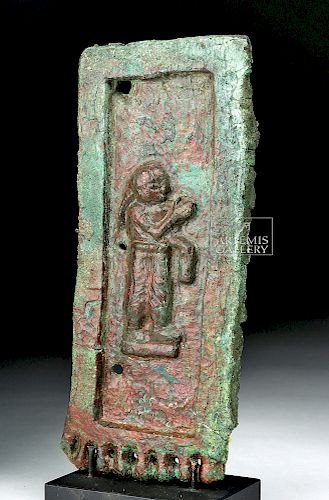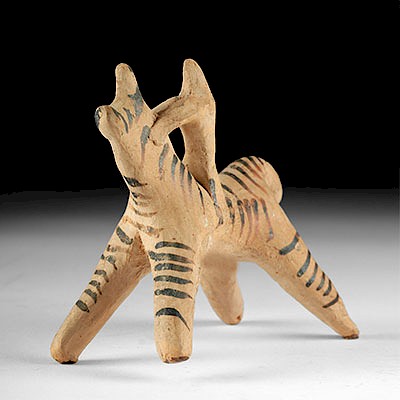Roman Leaded Bronze Plaque w/ Worshipper
Lot 58
About Seller
Artemis Fine Arts
686 S Taylor Ave, Ste 106
Louisville, CO 80027
United States
Selling antiquities, ancient and ethnographic art online since 1993, Artemis Gallery specializes in Classical Antiquities (Egyptian, Greek, Roman, Near Eastern), Asian, Pre-Columbian, African / Tribal / Oceanographic art. Our extensive inventory includes pottery, stone, metal, wood, glass and textil...Read more
Estimate:
$2,200 - $3,300
Absentee vs Live bid
Two ways to bid:
- Leave a max absentee bid and the platform will bid on your behalf up to your maximum bid during the live auction.
- Bid live during the auction and your bids will be submitted real-time to the auctioneer.
Bid Increments
| Price | Bid Increment |
|---|---|
| $0 | $25 |
| $300 | $50 |
| $1,000 | $100 |
| $2,000 | $250 |
| $5,000 | $500 |
| $10,000 | $1,000 |
| $20,000 | $2,500 |
| $50,000 | $5,000 |
| $100,000 | $10,000 |
| $200,000 | $20,000 |
About Auction
By Artemis Fine Arts
Oct 25, 2018
Set Reminder
2018-10-25 11:00:00
2018-10-25 11:00:00
America/New_York
Bidsquare
Bidsquare : Antiquities from Egypt, Greece, Italy, Asia
https://www.bidsquare.com/auctions/artemis-gallery/antiquities-from-egypt-greece-italy-asia-3538
Featuring Egyptian, Greek, Roman, Etruscan, Near Eastern, plus Asian art from Central and Far East. If you love the classics, this is the sale for you. Artemis Fine Arts info@artemisfinearts.com
Featuring Egyptian, Greek, Roman, Etruscan, Near Eastern, plus Asian art from Central and Far East. If you love the classics, this is the sale for you. Artemis Fine Arts info@artemisfinearts.com
- Lot Description
Roman, Imperial period, ca. 1st to 3rd century CE. A decorative plaque, composed of a sheet of bronze with a molded sheet of leaded bronze pressed against it. The plaque depicts a relief figure, shown standing in profile, wearing a long skirt and holding a cup. This is probably a votive figure, depicting a worshipper making an offering of libations, but time has worn away the identifying details. The figure is within a raised border. Three drilled holes through the left side (facing of the piece) would have allowed it to be attached to something else. The lower part of the plaque also has six holes drilled through it, again, probably for attachment. Size: 3.25" W x 8.3" H (8.3 cm x 21.1 cm); 9.15" H (23.2 cm) on included custom stand.
The Romans used lead in their copper alloys for more complex moldings, because, although leaded alloys are more likely to crack when hammered, they are more fluid when molten and will easily flow into a mold at a lower temperature than bronze without lead. That may explain why this piece is made of two sheets, with the more complex molded side formed of a high-lead copper alloy. Roman metalworkers clearly understood the technical properties of the metals they worked with and used them to their advantage.
Provenance: private Houston, Texas, USA collection
All items legal to buy/sell under U.S. Statute covering cultural patrimony Code 2600, CHAPTER 14, and are guaranteed to be as described or your money back.
A Certificate of Authenticity will accompany all winning bids.
We ship worldwide and handle all shipping in-house for your convenience.
#133006Fascinating mottled green and dark red patina. Repaired from two pieces (repair line is low on the body) with some adhesive visible on the undecorated back. Form is clear, with some remaining detail.Condition
- Shipping Info
-
All shipping is handled in-house for your convenience. Your invoice from Artemis Gallery will include shipping calculation instructions. If in doubt, please inquire BEFORE bidding for estimated shipping costs for individual items.
-
- Buyer's Premium



 EUR
EUR CAD
CAD AUD
AUD GBP
GBP MXN
MXN HKD
HKD CNY
CNY MYR
MYR SEK
SEK SGD
SGD CHF
CHF THB
THB
















